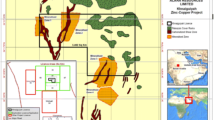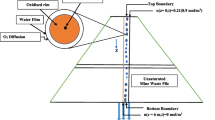Abstract
Former mining areas generally suffer numerous environmental problems such as groundwater contamination with heavy metals and acidification. A reactive hybrid transport model has been developed to allow the quantification of uranium transport in flooded underground mines. This hybrid model specifically takes into account two different transport time scales within an underground mine, which result from the existence of a network of highly conductive shafts, drifts or ventilation raises within the considerably less permeable ore material in the underground. This paper introduces the model concept and addresses potential model applications.
Access this chapter
Tax calculation will be finalised at checkout
Purchases are for personal use only
Preview
Unable to display preview. Download preview PDF.
Similar content being viewed by others
References
Bajracharya K., Barry D.A. (1993). Mixing cell models for nonlinear equilibrium single species adsorption and transport. J. Contam Hydrology 12: 227-243.
Barenblatt G.I., Zheltov LP., Kochina I.N. (1960). Basic concepts in the theory of seepage of homogeneous liquids in fissured rocks. J Appl Math and Mech 24: 1286-1303.
Bain J.G., Mayer K.U., Blowes D.W., Frind E.O., Molson J.W.H., Kahnt R., Jenk, U. (2001). Modelling the closure-related geochemical evolution of groundwater at a former uranium mine. J Contam Hydrology 52: 109-135.
Birk S. (2001): Characterisation of karst systems by simulating aquifer genesis and spring responses: model development and application to gypsum karst. Geowissenschaftliche Arbeiten, C60, Tübingen, Germany.
Clemens T., Hückinghaus D., Sauter M., Liedl R., Teutsch G. (1996). A combined continuum and discrete network reactive transport model for the simulation of karst development. Proc ModelCARE 1996, Golden, Colorado, IAHS Publ. 237: 309-318.
Engesgaard P., Kipp K.L. (1992). A geochemical transport model for redox-controlled movement of mineral fronts in groundwater flow systems: A case of nitrate removal by oxidation of pyrite. Water Resour Res 28: 2829-2843.
Liu G., Wang P., Zheng C. (2001). An explicit and mass-conservative scheme without time-step limit for modeling advection-dominated contaminant transport, 2001 MODFLOW international conference in Golden, Colorado.
Parkhurst D.L., Appelo C.A.J. (1999). User’s guide to PHREEQC (version 2) - a computer program for speciation, batch-reaction, one-dimensional transport, and inverse geochemical calculations. Water-Resources Investigations Report 99-4259, U.S. Dept. of the Interior, U.S. Geological Survey.
Prommer H., Bajyrry D.A., Zheng C. (2002). MODFLOW/MT3DMS based reactive multicomponent transport modelling. Accepted for publication in Ground Water.
Spiessl S.M., Sauter M., Zheng C., Liu G. (2002). Simulation of contaminant transport in flooded underground mines using a coupled continuum-conduit transport model: Comparison of two numerical methods for advection in the pipe network. Submitted to Proc ModelCARE 2002, Prag, 17-20 June 2002.
Steefel C.I., MacQuarrie K.T.B. (1996). Approaches to modeling of reactive transport in porous media. In: Reactive Transport in Porous Media (ed. by P. C. Lichtner P.C., Steefel C.I., Oelkers E.H.) Min. Soc. Of America, 1996, 83-129.
Walter A.L., Frind E.O., Blowes D.W., Ptacek C.J., Molson J.W. (1994). Modeling of multicomponent reactive transport in groundwater. 1. Model development and evaluation. Water Resour Res 30: 3137-3148.
Wunderly M.D., Blowes D.W., Frind E.O., Ptacek C.J. (1996). Sulfide mineral oxidation and subsequent reactive transport of oxidation products in mine tailings impoundments: A numerical model. Water Resour Res 32: 3173-3187.
Yeh G.T., Tripathi V.S. (1989). A critical evaluation of recent developments in hydrogeo-chemical transport models of reactive multichemical components, Water Resour Res 25: 93-108.
Zheng C., Wang P.P. (1999). MT3DMS: A modular three-dimensional multispecies model for simulation of advection, dispersion and chemical reactions of contaminants in groundwater systems; Documentation and User’s Guide, Contract Report SERDP-99-1, U.S. Army Engineer Research and Development Center, Vicksburg, MS.
Author information
Authors and Affiliations
Editor information
Editors and Affiliations
Rights and permissions
Copyright information
© 2002 Springer-Verlag Berlin Heidelberg
About this paper
Cite this paper
Spiessl, S.M., Prommer, H., Sauter, M., Zheng, C. (2002). Numerical simulation of uranium transport in flooded underground mines. In: Merkel, B.J., Planer-Friedrich, B., Wolkersdorfer, C. (eds) Uranium in the Aquatic Environment. Springer, Berlin, Heidelberg. https://doi.org/10.1007/978-3-642-55668-5_31
Download citation
DOI: https://doi.org/10.1007/978-3-642-55668-5_31
Publisher Name: Springer, Berlin, Heidelberg
Print ISBN: 978-3-642-62877-1
Online ISBN: 978-3-642-55668-5
eBook Packages: Springer Book Archive




